Chenchen Zhang
OpenCoder: The Open Cookbook for Top-Tier Code Large Language Models
Nov 07, 2024



Abstract:Large language models (LLMs) for code have become indispensable in various domains, including code generation, reasoning tasks and agent systems.While open-access code LLMs are increasingly approaching the performance levels of proprietary models, high-quality code LLMs suitable for rigorous scientific investigation, particularly those with reproducible data processing pipelines and transparent training protocols, remain limited. The scarcity is due to various challenges, including resource constraints, ethical considerations, and the competitive advantages of keeping models advanced. To address the gap, we introduce OpenCoder, a top-tier code LLM that not only achieves performance comparable to leading models but also serves as an ``open cookbook'' for the research community. Unlike most prior efforts, we release not only model weights and inference code, but also the reproducible training data, complete data processing pipeline, rigorous experimental ablation results, and detailed training protocols for open scientific research. Through this comprehensive release, we identify the key ingredients for building a top-tier code LLM: (1) code optimized heuristic rules for data cleaning and methods for data deduplication, (2) recall of text corpus related to code and (3) high-quality synthetic data in both annealing and supervised fine-tuning stages. By offering this level of openness, we aim to broaden access to all aspects of a top-tier code LLM, with OpenCoder serving as both a powerful model and an open foundation to accelerate research, and enable reproducible advancements in code AI.
Hunyuan-Large: An Open-Source MoE Model with 52 Billion Activated Parameters by Tencent
Nov 05, 2024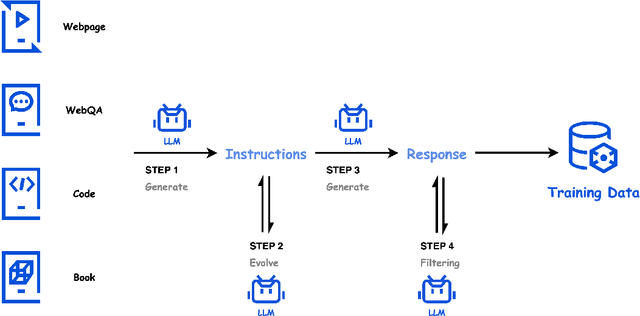
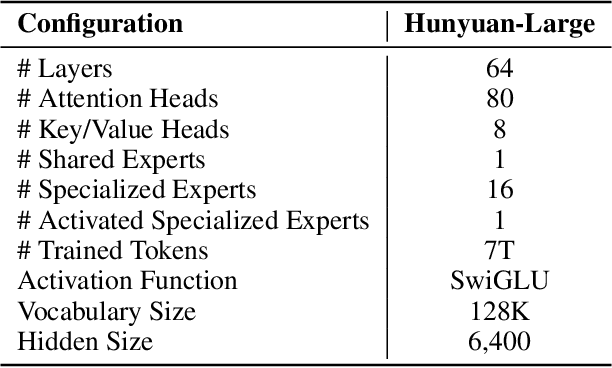
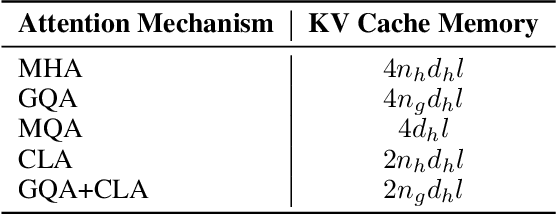
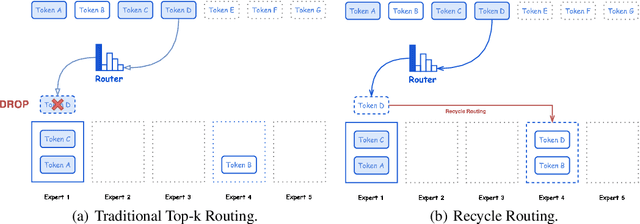
Abstract:In this paper, we introduce Hunyuan-Large, which is currently the largest open-source Transformer-based mixture of experts model, with a total of 389 billion parameters and 52 billion activation parameters, capable of handling up to 256K tokens. We conduct a thorough evaluation of Hunyuan-Large's superior performance across various benchmarks including language understanding and generation, logical reasoning, mathematical problem-solving, coding, long-context, and aggregated tasks, where it outperforms LLama3.1-70B and exhibits comparable performance when compared to the significantly larger LLama3.1-405B model. Key practice of Hunyuan-Large include large-scale synthetic data that is orders larger than in previous literature, a mixed expert routing strategy, a key-value cache compression technique, and an expert-specific learning rate strategy. Additionally, we also investigate the scaling laws and learning rate schedule of mixture of experts models, providing valuable insights and guidances for future model development and optimization. The code and checkpoints of Hunyuan-Large are released to facilitate future innovations and applications. Codes: https://github.com/Tencent/Hunyuan-Large Models: https://huggingface.co/tencent/Tencent-Hunyuan-Large
MTU-Bench: A Multi-granularity Tool-Use Benchmark for Large Language Models
Oct 15, 2024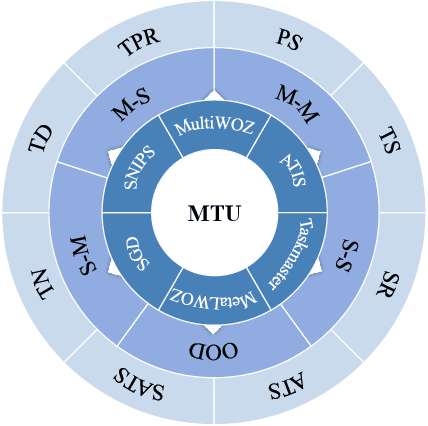
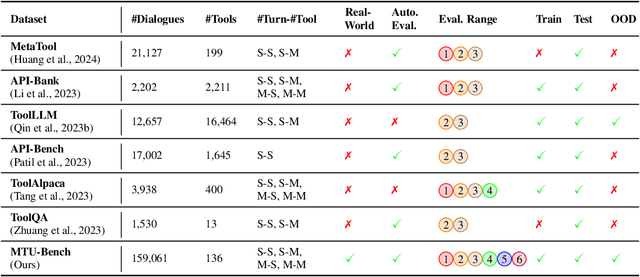
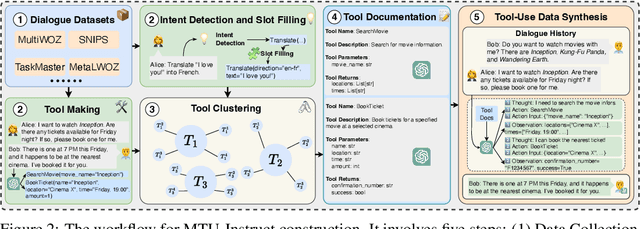
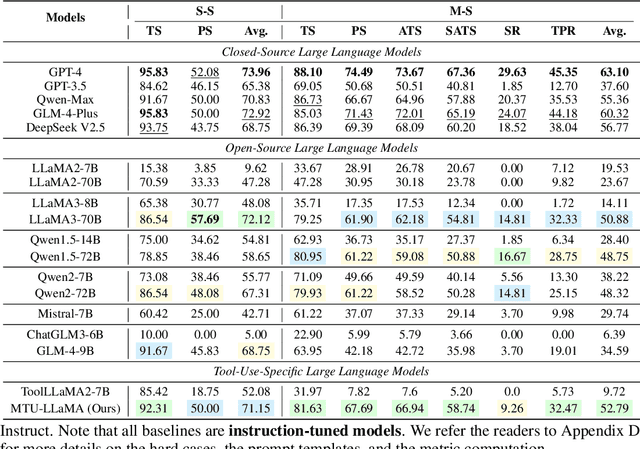
Abstract:Large Language Models (LLMs) have displayed massive improvements in reasoning and decision-making skills and can hold natural conversations with users. Recently, many tool-use benchmark datasets have been proposed. However, existing datasets have the following limitations: (1). Insufficient evaluation scenarios (e.g., only cover limited tool-use scenes). (2). Extensive evaluation costs (e.g., GPT API costs). To address these limitations, in this work, we propose a multi-granularity tool-use benchmark for large language models called MTU-Bench. For the "multi-granularity" property, our MTU-Bench covers five tool usage scenes (i.e., single-turn and single-tool, single-turn and multiple-tool, multiple-turn and single-tool, multiple-turn and multiple-tool, and out-of-distribution tasks). Besides, all evaluation metrics of our MTU-Bench are based on the prediction results and the ground truth without using any GPT or human evaluation metrics. Moreover, our MTU-Bench is collected by transforming existing high-quality datasets to simulate real-world tool usage scenarios, and we also propose an instruction dataset called MTU-Instruct data to enhance the tool-use abilities of existing LLMs. Comprehensive experimental results demonstrate the effectiveness of our MTU-Bench. Code and data will be released at https: //github.com/MTU-Bench-Team/MTU-Bench.git.
DDK: Distilling Domain Knowledge for Efficient Large Language Models
Jul 23, 2024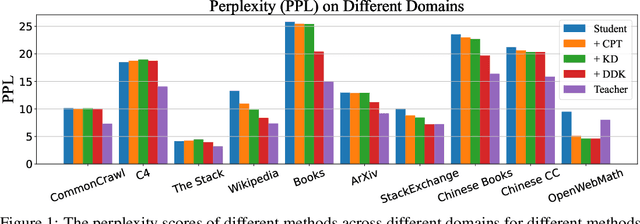

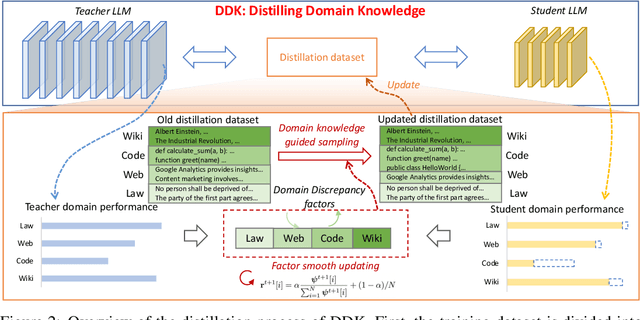

Abstract:Despite the advanced intelligence abilities of large language models (LLMs) in various applications, they still face significant computational and storage demands. Knowledge Distillation (KD) has emerged as an effective strategy to improve the performance of a smaller LLM (i.e., the student model) by transferring knowledge from a high-performing LLM (i.e., the teacher model). Prevailing techniques in LLM distillation typically use a black-box model API to generate high-quality pretrained and aligned datasets, or utilize white-box distillation by altering the loss function to better transfer knowledge from the teacher LLM. However, these methods ignore the knowledge differences between the student and teacher LLMs across domains. This results in excessive focus on domains with minimal performance gaps and insufficient attention to domains with large gaps, reducing overall performance. In this paper, we introduce a new LLM distillation framework called DDK, which dynamically adjusts the composition of the distillation dataset in a smooth manner according to the domain performance differences between the teacher and student models, making the distillation process more stable and effective. Extensive evaluations show that DDK significantly improves the performance of student models, outperforming both continuously pretrained baselines and existing knowledge distillation methods by a large margin.
LongIns: A Challenging Long-context Instruction-based Exam for LLMs
Jun 26, 2024Abstract:The long-context capabilities of large language models (LLMs) have been a hot topic in recent years. To evaluate the performance of LLMs in different scenarios, various assessment benchmarks have emerged. However, as most of these benchmarks focus on identifying key information to answer questions, which mainly requires the retrieval ability of LLMs, these benchmarks can partially represent the reasoning performance of LLMs from large amounts of information. Meanwhile, although LLMs often claim to have context windows of 32k, 128k, 200k, or even longer, these benchmarks fail to reveal the actual supported length of these LLMs. To address these issues, we propose the LongIns benchmark dataset, a challenging long-context instruction-based exam for LLMs, which is built based on the existing instruction datasets. Specifically, in our LongIns, we introduce three evaluation settings: Global Instruction & Single Task (GIST), Local Instruction & Single Task (LIST), and Local Instruction & Multiple Tasks (LIMT). Based on LongIns, we perform comprehensive evaluations on existing LLMs and have the following important findings: (1). The top-performing GPT-4 with 128k context length performs poorly on the evaluation context window of 16k in our LongIns. (2). For the multi-hop reasoning ability of many existing LLMs, significant efforts are still needed under short context windows (less than 4k).
GIEBench: Towards Holistic Evaluation of Group Identity-based Empathy for Large Language Models
Jun 24, 2024
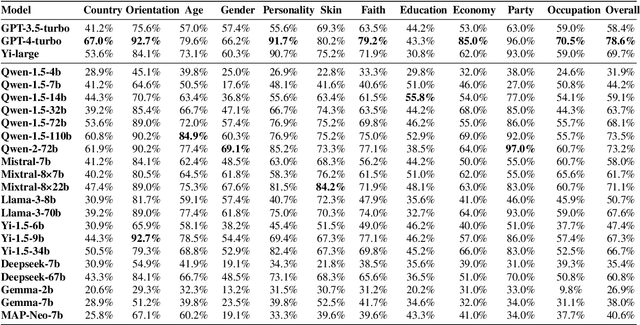

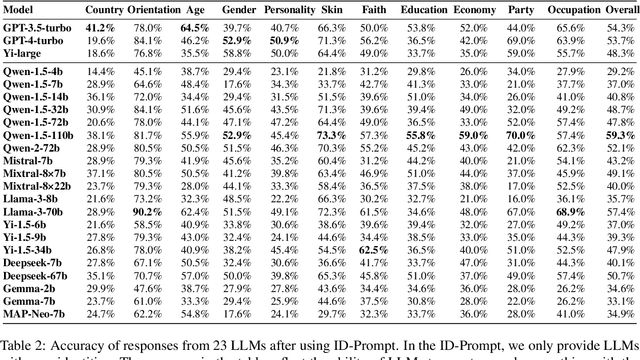
Abstract:As large language models (LLMs) continue to develop and gain widespread application, the ability of LLMs to exhibit empathy towards diverse group identities and understand their perspectives is increasingly recognized as critical. Most existing benchmarks for empathy evaluation of LLMs focus primarily on universal human emotions, such as sadness and pain, often overlooking the context of individuals' group identities. To address this gap, we introduce GIEBench, a comprehensive benchmark that includes 11 identity dimensions, covering 97 group identities with a total of 999 single-choice questions related to specific group identities. GIEBench is designed to evaluate the empathy of LLMs when presented with specific group identities such as gender, age, occupation, and race, emphasizing their ability to respond from the standpoint of the identified group. This supports the ongoing development of empathetic LLM applications tailored to users with different identities. Our evaluation of 23 LLMs revealed that while these LLMs understand different identity standpoints, they fail to consistently exhibit equal empathy across these identities without explicit instructions to adopt those perspectives. This highlights the need for improved alignment of LLMs with diverse values to better accommodate the multifaceted nature of human identities. Our datasets are available at https://github.com/GIEBench/GIEBench.
R2C2-Coder: Enhancing and Benchmarking Real-world Repository-level Code Completion Abilities of Code Large Language Models
Jun 04, 2024



Abstract:Code completion models have made significant progress in recent years. Recently, repository-level code completion has drawn more attention in modern software development, and several baseline methods and benchmarks have been proposed. However, existing repository-level code completion methods often fall short of fully using the extensive context of a project repository, such as the intricacies of relevant files and class hierarchies. Besides, the existing benchmarks usually focus on limited code completion scenarios, which cannot reflect the repository-level code completion abilities well of existing methods. To address these limitations, we propose the R2C2-Coder to enhance and benchmark the real-world repository-level code completion abilities of code Large Language Models, where the R2C2-Coder includes a code prompt construction method R2C2-Enhance and a well-designed benchmark R2C2-Bench. Specifically, first, in R2C2-Enhance, we first construct the candidate retrieval pool and then assemble the completion prompt by retrieving from the retrieval pool for each completion cursor position. Second, based on R2C2 -Enhance, we can construct a more challenging and diverse R2C2-Bench with training, validation and test splits, where a context perturbation strategy is proposed to simulate the real-world repository-level code completion well. Extensive results on multiple benchmarks demonstrate the effectiveness of our R2C2-Coder.
D-CPT Law: Domain-specific Continual Pre-Training Scaling Law for Large Language Models
Jun 03, 2024



Abstract:Continual Pre-Training (CPT) on Large Language Models (LLMs) has been widely used to expand the model's fundamental understanding of specific downstream domains (e.g., math and code). For the CPT on domain-specific LLMs, one important question is how to choose the optimal mixture ratio between the general-corpus (e.g., Dolma, Slim-pajama) and the downstream domain-corpus. Existing methods usually adopt laborious human efforts by grid-searching on a set of mixture ratios, which require high GPU training consumption costs. Besides, we cannot guarantee the selected ratio is optimal for the specific domain. To address the limitations of existing methods, inspired by the Scaling Law for performance prediction, we propose to investigate the Scaling Law of the Domain-specific Continual Pre-Training (D-CPT Law) to decide the optimal mixture ratio with acceptable training costs for LLMs of different sizes. Specifically, by fitting the D-CPT Law, we can easily predict the general and downstream performance of arbitrary mixture ratios, model sizes, and dataset sizes using small-scale training costs on limited experiments. Moreover, we also extend our standard D-CPT Law on cross-domain settings and propose the Cross-Domain D-CPT Law to predict the D-CPT law of target domains, where very small training costs (about 1% of the normal training costs) are needed for the target domains. Comprehensive experimental results on six downstream domains demonstrate the effectiveness and generalizability of our proposed D-CPT Law and Cross-Domain D-CPT Law.
MAP-Neo: Highly Capable and Transparent Bilingual Large Language Model Series
May 29, 2024

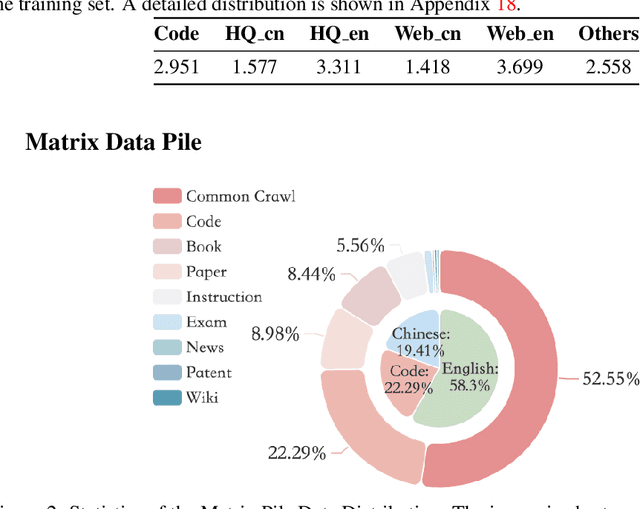

Abstract:Large Language Models (LLMs) have made great strides in recent years to achieve unprecedented performance across different tasks. However, due to commercial interest, the most competitive models like GPT, Gemini, and Claude have been gated behind proprietary interfaces without disclosing the training details. Recently, many institutions have open-sourced several strong LLMs like LLaMA-3, comparable to existing closed-source LLMs. However, only the model's weights are provided with most details (e.g., intermediate checkpoints, pre-training corpus, and training code, etc.) being undisclosed. To improve the transparency of LLMs, the research community has formed to open-source truly open LLMs (e.g., Pythia, Amber, OLMo), where more details (e.g., pre-training corpus and training code) are being provided. These models have greatly advanced the scientific study of these large models including their strengths, weaknesses, biases and risks. However, we observe that the existing truly open LLMs on reasoning, knowledge, and coding tasks are still inferior to existing state-of-the-art LLMs with similar model sizes. To this end, we open-source MAP-Neo, a highly capable and transparent bilingual language model with 7B parameters trained from scratch on 4.5T high-quality tokens. Our MAP-Neo is the first fully open-sourced bilingual LLM with comparable performance compared to existing state-of-the-art LLMs. Moreover, we open-source all details to reproduce our MAP-Neo, where the cleaned pre-training corpus, data cleaning pipeline, checkpoints, and well-optimized training/evaluation framework are provided. Finally, we hope our MAP-Neo will enhance and strengthen the open research community and inspire more innovations and creativities to facilitate the further improvements of LLMs.
ConceptMath: A Bilingual Concept-wise Benchmark for Measuring Mathematical Reasoning of Large Language Models
Feb 23, 2024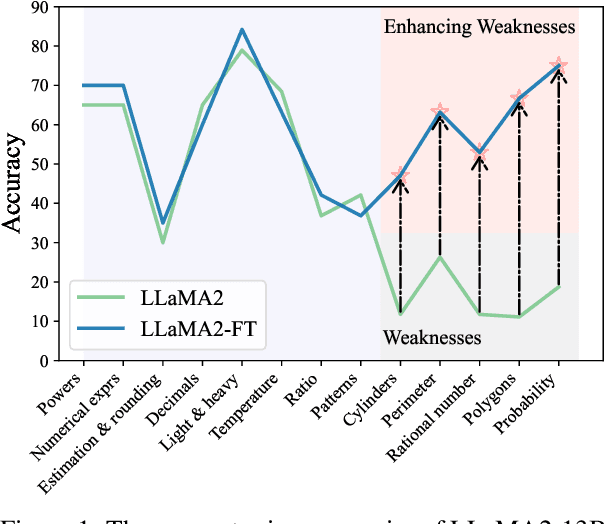
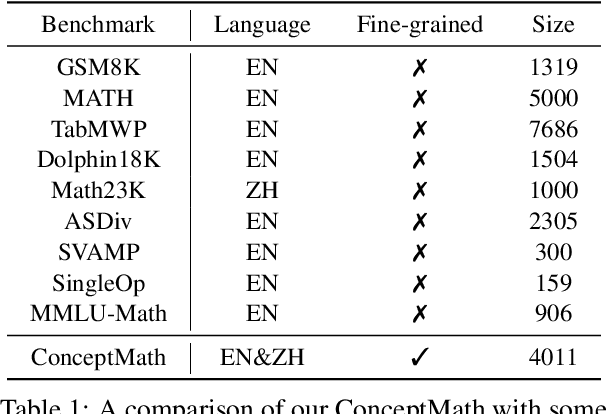
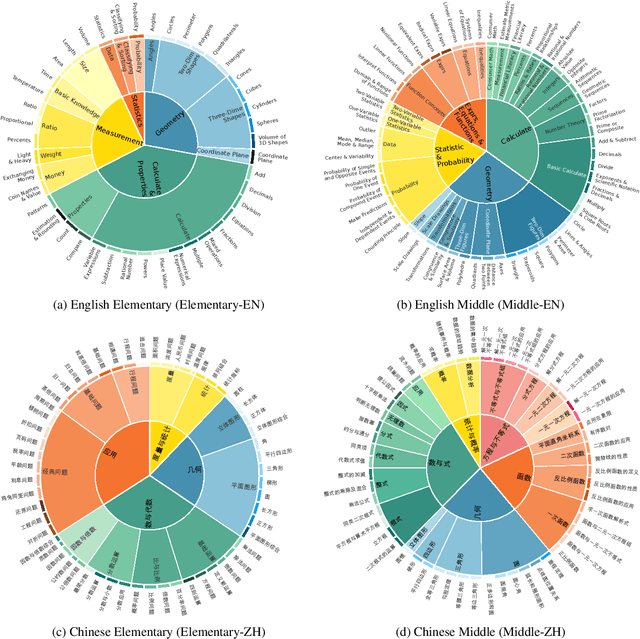
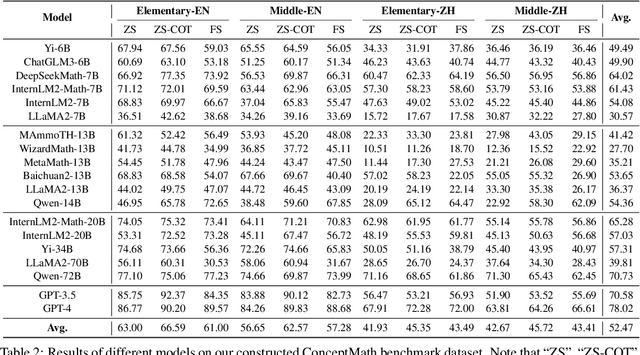
Abstract:This paper introduces ConceptMath, a bilingual (English and Chinese), fine-grained benchmark that evaluates concept-wise mathematical reasoning of Large Language Models (LLMs). Unlike traditional benchmarks that evaluate general mathematical reasoning with an average accuracy, ConceptMath systematically organizes math problems under a hierarchy of math concepts, so that mathematical reasoning can be evaluated at different granularity with concept-wise accuracies. Based on our ConcepthMath, we evaluate a broad range of LLMs, and we observe existing LLMs, though achieving high average accuracies on traditional benchmarks, exhibit significant performance variations across different math concepts and may even fail catastrophically on the most basic ones. Besides, we also introduce an efficient fine-tuning strategy to enhance the weaknesses of existing LLMs. Finally, we hope ConceptMath could guide the developers to understand the fine-grained mathematical abilities of their models and facilitate the growth of foundation models.
 Add to Chrome
Add to Chrome Add to Firefox
Add to Firefox Add to Edge
Add to Edge